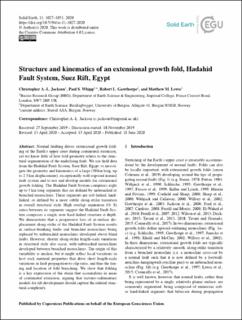| dc.contributor.author | Jackson, Christopher A.-L. | |
| dc.contributor.author | Whipp, Paul S. | |
| dc.contributor.author | Gawthorpe, Robert | |
| dc.contributor.author | Lewis, Matthew M. | |
| dc.date.accessioned | 2021-05-14T09:58:50Z | |
| dc.date.available | 2021-05-14T09:58:50Z | |
| dc.date.created | 2020-08-23T13:31:30Z | |
| dc.date.issued | 2020 | |
| dc.Published | Solid Earth (SE). 2020, 11 (3), 1027-1051. | |
| dc.identifier.issn | 1869-9510 | |
| dc.identifier.uri | https://hdl.handle.net/11250/2755270 | |
| dc.description.abstract | Normal faulting drives extensional growth folding of the Earth's upper crust during continental extension, yet we know little of how fold geometry relates to the structural segmentation of the underlying fault. We use field data from the Hadahid Fault System, Suez Rift, Egypt, to investigate the geometry and kinematics of a large (30 km long, up to 2.5 km displacement), exceptionally well-exposed normal fault system and to test and develop models for extensional growth folding. The Hadahid Fault System comprises eight up to 5 km long segments that are defined by unbreached or breached monoclines. These segments are soft-linked, hard-linked, or defined by a more subtle along-strike transition in overall structural style. High overlap : separation (O:S) ratios between its segments suggest the Hadahid Fault System comprises a single, now hard-linked structure at depth. We demonstrate that a progressive loss of at-surface displacement along-strike of the Hadahid Fault System results in surface-breaking faults and breached monoclines being replaced by unbreached monoclines developed above blind faults. However, shorter along-strike length-scale variations in structural style also occur, with unbreached monoclines developed between breached monoclines. The origin of this variability is unclear, but it might reflect local variations in host rock material properties that drive short length-scale variations in fault propagation-to-slip ratio, and thus the timing and location of fold breaching. We show that folding is a key expression of the strain that accumulates in areas of continental extension, arguing that tectono-sedimentary models for rift development should capture the related structural complexity. | en_US |
| dc.language.iso | eng | en_US |
| dc.publisher | Copernicus | en_US |
| dc.rights | Navngivelse 4.0 Internasjonal | * |
| dc.rights.uri | http://creativecommons.org/licenses/by/4.0/deed.no | * |
| dc.title | Structure and kinematics of an extensional growth fold, Hadahid Fault System, Suez Rift, Egypt | en_US |
| dc.type | Journal article | en_US |
| dc.type | Peer reviewed | en_US |
| dc.description.version | publishedVersion | en_US |
| dc.rights.holder | Copyright the authors 2020. | en_US |
| cristin.ispublished | true | |
| cristin.fulltext | original | |
| cristin.qualitycode | 1 | |
| dc.identifier.doi | 10.5194/se-11-1027-2020 | |
| dc.identifier.cristin | 1824644 | |
| dc.source.journal | Solid Earth (SE) | en_US |
| dc.source.40 | 11 | |
| dc.source.14 | 3 | |
| dc.source.pagenumber | 1027-1051 | en_US |
| dc.identifier.citation | Solid Earth (SE). 2020, 11, 1027–1051. | en_US |
| dc.source.volume | 11 | en_US |

